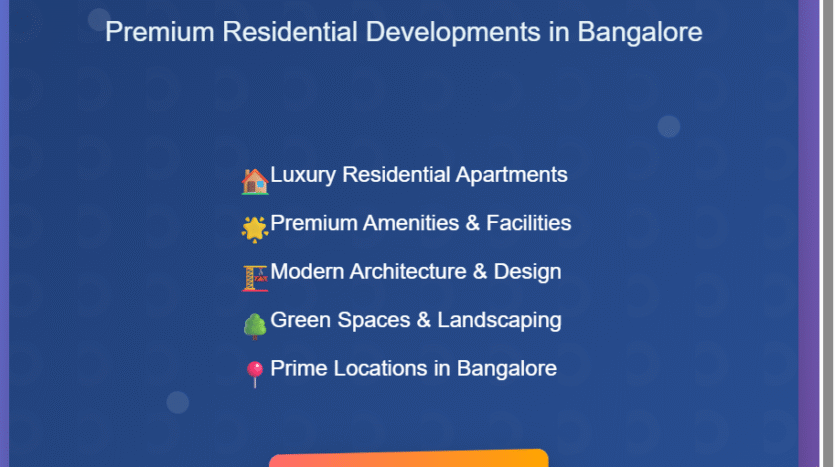SBR Projects in Bangalore: Transforming Urban Living Through Rehabilitation
Bangalore, India’s Silicon Valley, has witnessed remarkable urban transformation over the past decade. Among the most significant developments are the Slum Board Rehabilitation (SBR) projects, which represent a crucial step toward inclusive urban development. These projects aim to provide dignified housing solutions while maintaining the social fabric of existing communities.
Understanding SBR Projects
SBR projects in Bangalore are government-initiated housing schemes designed to rehabilitate slum dwellers into proper residential complexes. These developments are typically managed by the Karnataka Slum Development Board and various housing corporations, ensuring that vulnerable populations have access to basic amenities and secure housing.
Key Features of SBR Projects
Housing Specifications
Most SBR projects in Bangalore offer compact yet functional living spaces. The typical unit sizes range from 200 to 400 square feet, designed to accommodate small to medium families. These apartments usually feature:
- One or two bedrooms with attached bathrooms
- Compact kitchen areas with basic fittings
- Balconies in selected units
- Adequate ventilation and natural lighting
- Basic electrical and plumbing infrastructure
Modern Amenities
Contemporary SBR projects incorporate essential amenities to ensure quality living:
- 24/7 water supply with overhead tanks
- Electricity connections with individual meters
- Waste management systems
- Community halls for social gatherings
- Children’s play areas
- Basic security arrangements
- Parking facilities where space permits
Strategic Locations and Surroundings
Connectivity Advantages
SBR projects are strategically located to ensure residents maintain their livelihood connections:
Public Transportation: Most projects are situated within walking distance of BMTC bus stops, with many having access to metro connectivity. This ensures residents can commute to their workplaces without significant additional costs.
Employment Hubs: Projects are often located near industrial areas, markets, and commercial zones where residents typically find employment opportunities in sectors like construction, domestic work, small businesses, and informal services.
Neighborhood Infrastructure
The surrounding areas of SBR projects typically include:
- Government schools and anganwadi centers
- Primary health centers or hospitals
- Local markets and grocery stores
- Banks and ATM facilities
- Religious centers catering to diverse communities
Notable SBR Projects Across Bangalore
Electronic City Region
Several SBR projects in the Electronic City area benefit from proximity to major IT companies and manufacturing units. The surrounding infrastructure includes well-developed roads, shopping complexes, and educational institutions.
Whitefield Corridor
Projects along the Whitefield corridor offer excellent connectivity to the IT sector while maintaining access to traditional employment opportunities. The area features a mix of urban amenities and local markets.
North Bangalore
SBR developments in areas like Yelahanka and Hebbal provide residents with access to both the airport corridor employment opportunities and the city center through metro connectivity.
South Bangalore
Projects in areas like Bannerghatta Road and Hosur Road benefit from proximity to educational institutions, hospitals, and emerging commercial centers.
Community Integration and Social Impact
Preserving Social Networks
One of the key highlights of successful SBR projects is their approach to maintaining existing community bonds. Families from the same original settlements are often relocated together, preserving social support systems and cultural connections.
Women’s Empowerment
Many SBR projects incorporate women’s self-help groups and skill development programs, enabling female residents to develop entrepreneurial skills and contribute to household income.
Children’s Development
Access to nearby schools and the provision of safe play areas within the complexes contribute significantly to children’s educational and social development.
Challenges and Ongoing Improvements
Infrastructure Development
While basic amenities are provided, ongoing maintenance and infrastructure upgrades remain areas of focus. Regular water supply, proper sewage systems, and waste management require continuous attention.
Livelihood Transition
Some residents face challenges adapting to new locations, particularly if they’re farther from their traditional work areas. However, improved public transportation and skill development programs help address these concerns.
Community Adaptation
The transition from informal settlements to formal housing complexes requires adaptation to new community management systems and maintenance responsibilities.
Future Outlook
The success of SBR projects in Bangalore demonstrates the potential for inclusive urban development. Future projects are likely to incorporate:
- Better integration with city planning initiatives
- Enhanced amenities and larger living spaces
- Improved connectivity to employment centers
- Sustainable construction practices
- Technology integration for better community management
Conclusion
SBR projects in Bangalore represent a significant step toward creating an inclusive city that provides dignity and opportunity for all residents. While challenges remain, these developments showcase how thoughtful urban planning can transform lives while preserving community bonds.
The strategic location of these projects, combined with basic amenities and community-focused design, creates foundations for improved quality of life. As Bangalore continues to grow, the lessons learned from SBR projects will be invaluable in shaping future urban development initiatives.
For families considering SBR housing options, these projects offer not just shelter, but a pathway to formal urban citizenship with access to basic services, education, and economic opportunities. The ongoing success of these projects depends on continued government support, community participation, and adaptive management practices that respond to residents’ evolving needs.




